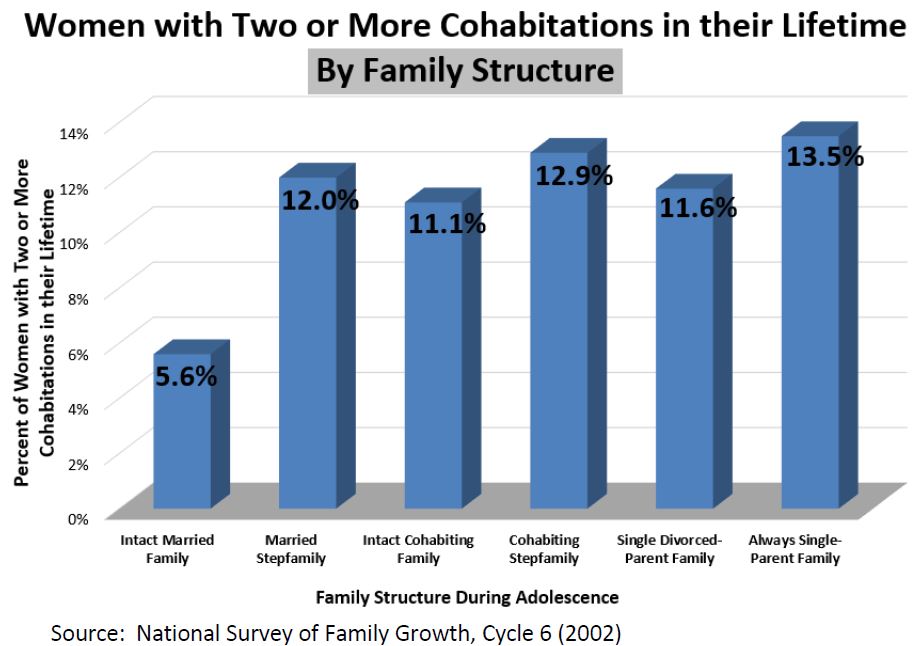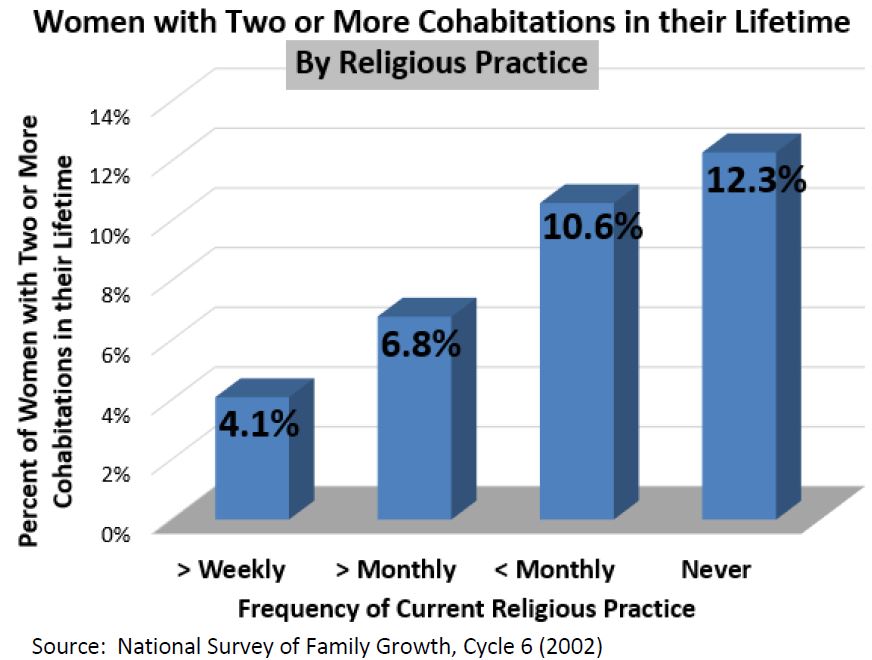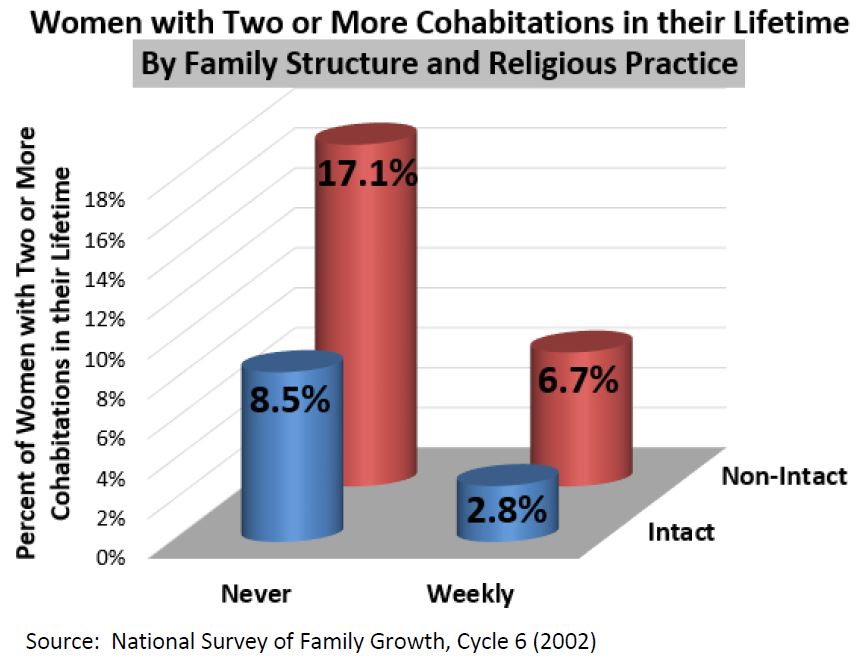Click Here to download “Women with Two or More Cohabitations in their Lifetime by Family Structure and Religious Practice”
Women with Two or More Cohabitations in their Lifetime by Family Structure and Religious Practice
Family Structure: According to the National Survey of Family Growth (2002), 5.6 percent of women (aged 14-44) who grew up in intact married families had two or more cohabitations in their lifetime, followed by women who grew up in intact cohabiting families (11.1 percent), those from single divorced parent families (11.6 percent), married stepfamilies (12 percent), cohabiting stepfamilies (12.9 percent), and always single parent families (13.5 percent). Overall, women raised in intact married families were only half as likely to have had two or more lifetime cohabitations as those from all other structures.
[1]  Religious Practice:
Religious Practice: The National Survey of Family Growth shows that 4.1 percent of women who worshiped at least weekly at the time of the survey had cohabited two or more times in their lifetime, followed by those who attended religious services between one and three times a month (6.8 percent), those who worshiped less than once a month (10.6 percent), and those who never attended religious services (12.3 percent).
 Family Structure and Religious Practice Combined:
Family Structure and Religious Practice Combined: Women (aged 14-44) who grew up in married intact families and who worshiped weekly at the time of the survey were the least likely to have had two or more cohabitations in their lifetime. According to the National Survey of Family Growth, 2.8 percent of women who grew up in intact married families and worshiped at least weekly had two or more cohabitations in their lifetime, followed by women who grew up in other family structures and worshiped at least weekly (6.7 percent), those who grew up in intact married families who never worshiped (8.5 percent), and those who grew up in other family structures and never worshiped (17.1 percent).
 Related Insights from Other Studies:
Related Insights from Other Studies: Several other studies corroborate the direction of these findings. Jeremy Uecker of the University of Texas at Austin and colleagues found that cohabiting young adults were less likely to attend religious services than their non-cohabiting peers.
[2]
David Eggebeen of Pennsylvania State University and Jeffrey Dew of the University of Virginia reported that adolescents who frequently attended church services were less likely to cohabit as adults.
[3]
Valerie Martin of McGill University and colleagues also found that children from divorced families were more likely to cohabit as adults than children from intact families.
[4]
As the evidence indicates, women who grew up in intact married families and worship at least weekly have had fewer cohabitations than those from other family structures who never worship.
[1] These charts draw on data collected by the National Survey of Family Growth, Cycle 6 (2002). The sample consists of 7,643 women between the ages of 14 and 44 who are statistically representative of all U.S. women.
[2] Jeremy E. Uecker, Mark D. Regnerus, and Margaret L. Vaaler, “Losing My Religion: The Social Sources of Religious Decline in Early Adulthood,”
Social Forces 85 (2007): 1667-92.
[3] David Eggebeen and Jeffrey Dew, “The Role of Religion in Adolescence for Family Formation in Young Adulthood,”
Journal of Marriage and Family 71 (2009): 108-21.
[4] Valerie Martin, Melinda Mills, and Celine Le Bourdais, “The Consequences of Parental Divorce on the Life Course Outcomes of Canadian Children,”
Canadian Studies in Population 32 (2005): 29-51.]]>
 Religious Practice: The National Survey of Family Growth shows that 4.1 percent of women who worshiped at least weekly at the time of the survey had cohabited two or more times in their lifetime, followed by those who attended religious services between one and three times a month (6.8 percent), those who worshiped less than once a month (10.6 percent), and those who never attended religious services (12.3 percent).
Religious Practice: The National Survey of Family Growth shows that 4.1 percent of women who worshiped at least weekly at the time of the survey had cohabited two or more times in their lifetime, followed by those who attended religious services between one and three times a month (6.8 percent), those who worshiped less than once a month (10.6 percent), and those who never attended religious services (12.3 percent).
 Family Structure and Religious Practice Combined: Women (aged 14-44) who grew up in married intact families and who worshiped weekly at the time of the survey were the least likely to have had two or more cohabitations in their lifetime. According to the National Survey of Family Growth, 2.8 percent of women who grew up in intact married families and worshiped at least weekly had two or more cohabitations in their lifetime, followed by women who grew up in other family structures and worshiped at least weekly (6.7 percent), those who grew up in intact married families who never worshiped (8.5 percent), and those who grew up in other family structures and never worshiped (17.1 percent).
Family Structure and Religious Practice Combined: Women (aged 14-44) who grew up in married intact families and who worshiped weekly at the time of the survey were the least likely to have had two or more cohabitations in their lifetime. According to the National Survey of Family Growth, 2.8 percent of women who grew up in intact married families and worshiped at least weekly had two or more cohabitations in their lifetime, followed by women who grew up in other family structures and worshiped at least weekly (6.7 percent), those who grew up in intact married families who never worshiped (8.5 percent), and those who grew up in other family structures and never worshiped (17.1 percent).
 Related Insights from Other Studies: Several other studies corroborate the direction of these findings. Jeremy Uecker of the University of Texas at Austin and colleagues found that cohabiting young adults were less likely to attend religious services than their non-cohabiting peers.[2]
David Eggebeen of Pennsylvania State University and Jeffrey Dew of the University of Virginia reported that adolescents who frequently attended church services were less likely to cohabit as adults.[3]
Valerie Martin of McGill University and colleagues also found that children from divorced families were more likely to cohabit as adults than children from intact families.[4]
As the evidence indicates, women who grew up in intact married families and worship at least weekly have had fewer cohabitations than those from other family structures who never worship.
[1] These charts draw on data collected by the National Survey of Family Growth, Cycle 6 (2002). The sample consists of 7,643 women between the ages of 14 and 44 who are statistically representative of all U.S. women.
[2] Jeremy E. Uecker, Mark D. Regnerus, and Margaret L. Vaaler, “Losing My Religion: The Social Sources of Religious Decline in Early Adulthood,” Social Forces 85 (2007): 1667-92.
[3] David Eggebeen and Jeffrey Dew, “The Role of Religion in Adolescence for Family Formation in Young Adulthood,” Journal of Marriage and Family 71 (2009): 108-21.
[4] Valerie Martin, Melinda Mills, and Celine Le Bourdais, “The Consequences of Parental Divorce on the Life Course Outcomes of Canadian Children,” Canadian Studies in Population 32 (2005): 29-51.]]>
Related Insights from Other Studies: Several other studies corroborate the direction of these findings. Jeremy Uecker of the University of Texas at Austin and colleagues found that cohabiting young adults were less likely to attend religious services than their non-cohabiting peers.[2]
David Eggebeen of Pennsylvania State University and Jeffrey Dew of the University of Virginia reported that adolescents who frequently attended church services were less likely to cohabit as adults.[3]
Valerie Martin of McGill University and colleagues also found that children from divorced families were more likely to cohabit as adults than children from intact families.[4]
As the evidence indicates, women who grew up in intact married families and worship at least weekly have had fewer cohabitations than those from other family structures who never worship.
[1] These charts draw on data collected by the National Survey of Family Growth, Cycle 6 (2002). The sample consists of 7,643 women between the ages of 14 and 44 who are statistically representative of all U.S. women.
[2] Jeremy E. Uecker, Mark D. Regnerus, and Margaret L. Vaaler, “Losing My Religion: The Social Sources of Religious Decline in Early Adulthood,” Social Forces 85 (2007): 1667-92.
[3] David Eggebeen and Jeffrey Dew, “The Role of Religion in Adolescence for Family Formation in Young Adulthood,” Journal of Marriage and Family 71 (2009): 108-21.
[4] Valerie Martin, Melinda Mills, and Celine Le Bourdais, “The Consequences of Parental Divorce on the Life Course Outcomes of Canadian Children,” Canadian Studies in Population 32 (2005): 29-51.]]>
